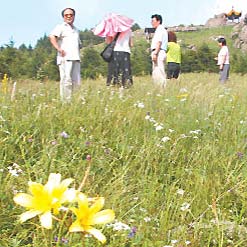
Baicaopan, the third highest mountain in Beijing becomes popular in the hot summer season thanks to its relatively lower temperatures than the urban area.
Baicaopan is just one peak of Baihua Mountain and it gets its name from several hundred kinds of herbs and flowers, such as azalea, Chinese herbaceous peony, lilac, morning star lily, and even wild poppies on the peak.
Located 120 kilometers southwest of central Beijing, Baicaopan boasts cool weather in the hottest three months in Northern China from July to September. The average summer temperature there is 20 degrees, 12 degrees lower than that in downtown Beijing.
Baicaopan is scenically attractive with a variety of habitat, including larch forests, alpine meadows, widespread deciduous cover, extensive areas of shrubs and rocky slopes.
There are more than 1,100 plant and 170 animal species, including brown-eared pheasants and possibly even leopards in the area.
Different from more low-lying areas, July and August is "spring time" for Baicaopan where dozens of different wild flowers blossom from July to September in the wake of the cool weather.
The top area of the mountain is covered by flowers. Butterflies and dragonflies are attracted to the natural flower garden.
Lots of birds are also interested in the well-protected forest. Part of the plateau of Baicaopan is covered in alpine meadows - supposedly ideal grazing ground for the brown-eared pheasant.
Unlike other mountainous areas in Beijing, even the highest peaks here are accessible to non-mountaineers and can be reached with relative ease along ridge walks. A cement passage was established in 2003 and tour buses can also take tourists to the top of the mountain.
As a natural botanical garden with more than 700 various kinds of trees, the area is famous for its yields of peaches, plums, apricots, persimmons, pears, walnuts, chestnuts and other fruits. Baicaopan is also a wild zoo. There are over 300 precious birds and many animals there.
According to the China Biodiversity website - one of the best English language sites on Chinese birds - many species can be found at Baihuashan and Baicaopan.
Birds like yellow-streaked warblers, collared scops-owls, eagle-owls, bull-headed shrikes and blue whistling thrushes can all be found here.
Apart from plants, flowers and birds, watching the sunrise is also an interesting event for visitors. At the top of the mountain, you can see the sun rising behind remote mountains. The great scenery is truly illuminated at daybreak.
But getting up early enough, may be a chore. It is best to camp on the mountain, if you plan to catch the sunrise. Usually the sun rises around 4:30 AM in July and August if you are watching from the top of the mountain.
So you should prepare well before 4:30 AM. There is no tour bus from the foot to the mountain top from 6:30 pm to 8:30 AM (the next morning). It is not recommended to walk to the top. If you walk along the cement road, it will take you almost four hours, and there is no shortcut to the top.
For those hoping to catch the sunrise, driving up yourself is probably the best idea, because you will be in charge of your own schedule.
The temperature at night on the mountain is about 15 degrees. You should take warm clothing up to the top of the mountain with you.
Some shops, teahouses and open-air camps are set up to meet the needs of tired mountaineers atop the mountain.
The apricot field at the foot of the mountain can offer you a pleasant time as well as a nutritious snack. The apricot orchard is about 602 hectares and the sweet fruits are ripe right now.
Generally a two-day trip can finish the main scenic spots at Baicaopan.
The first day of a trip should be spent going to the top of the mountain to admire flowers, alpine meadows, and the pine trees at sunrise if you can get up early enough.
The second day is a great time for exploring a long steep stone lane, which zigzags three kilometers to the other side of the mountain. The lane is covered by thick growth and sometimes you must pass through from a valley which is so narrow, only one person can pass at a time.
The long valley is flanked by steep mountains and is lined with woods, shrubs, attractive marshy area, and even some patches of reeds.
Amenities like hotels, restaurants and small shops are available at the foot of the mountain. The Tengma Hotel is one of the best.
To get there: Free shuttle buses run from downtown Beijing to the Tengma Hotel and further local transport is offered by local villagers every day.
The early bus leaves Tianqiao Bus Station at 7:30 AM and returns at 3:30 PM.
To drive there: go along Jingshi (Beijing-Shijiazhuang) Expressway to Yancun Exit and then go forward to Tuolizhen, Hebeizhen until you get to the 108 National Road. Drive another 105 kilometers along 108 National Road. Please note the road sign Baicaopan Natural Scenic Spot.
(China Daily July 15, 2005)
|

